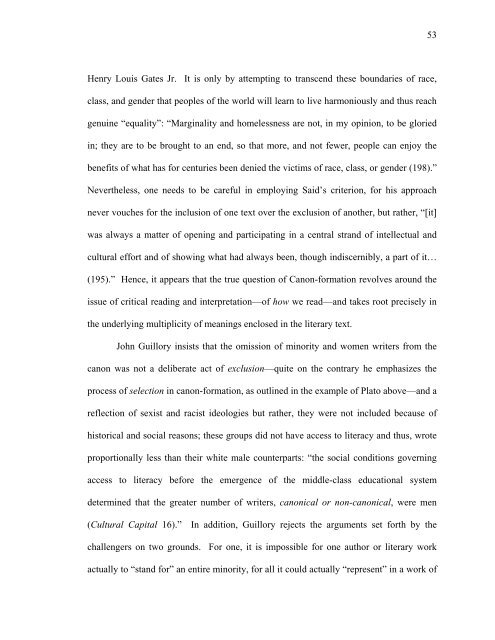Untitled - Sexey's School Moodle
Untitled - Sexey's School Moodle
Untitled - Sexey's School Moodle
Create successful ePaper yourself
Turn your PDF publications into a flip-book with our unique Google optimized e-Paper software.
Henry Louis Gates Jr. It is only by attempting to transcend these boundaries of race,<br />
class, and gender that peoples of the world will learn to live harmoniously and thus reach<br />
genuine “equality”: “Marginality and homelessness are not, in my opinion, to be gloried<br />
in; they are to be brought to an end, so that more, and not fewer, people can enjoy the<br />
benefits of what has for centuries been denied the victims of race, class, or gender (198).”<br />
Nevertheless, one needs to be careful in employing Said’s criterion, for his approach<br />
never vouches for the inclusion of one text over the exclusion of another, but rather, “[it]<br />
was always a matter of opening and participating in a central strand of intellectual and<br />
cultural effort and of showing what had always been, though indiscernibly, a part of it…<br />
(195).” Hence, it appears that the true question of Canon-formation revolves around the<br />
issue of critical reading and interpretation—of how we read—and takes root precisely in<br />
the underlying multiplicity of meanings enclosed in the literary text.<br />
John Guillory insists that the omission of minority and women writers from the<br />
canon was not a deliberate act of exclusion—quite on the contrary he emphasizes the<br />
process of selection in canon-formation, as outlined in the example of Plato above—and a<br />
reflection of sexist and racist ideologies but rather, they were not included because of<br />
historical and social reasons; these groups did not have access to literacy and thus, wrote<br />
proportionally less than their white male counterparts: “the social conditions governing<br />
access to literacy before the emergence of the middle-class educational system<br />
determined that the greater number of writers, canonical or non-canonical, were men<br />
(Cultural Capital 16).” In addition, Guillory rejects the arguments set forth by the<br />
challengers on two grounds. For one, it is impossible for one author or literary work<br />
actually to “stand for” an entire minority, for all it could actually “represent” in a work of<br />
53



